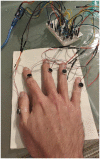Combining virtual reality and tactile stimulation to investigate embodied finger-based numerical representations
- PMID: 37179854
- PMCID: PMC10174462
- DOI: 10.3389/fpsyg.2023.1119561
Combining virtual reality and tactile stimulation to investigate embodied finger-based numerical representations
Abstract
Finger-based representation of numbers is a high-level cognitive strategy to assist numerical and arithmetic processing in children and adults. It is unclear whether this paradigm builds on simple perceptual features or comprises several attributes through embodiment. Here we describe the development and initial testing of an experimental setup to study embodiment during a finger-based numerical task using Virtual Reality (VR) and a low-cost tactile stimulator that is easy to build. Using VR allows us to create new ways to study finger-based numerical representation using a virtual hand that can be manipulated in ways our hand cannot, such as decoupling tactile and visual stimuli. The goal is to present a new methodology that can allow researchers to study embodiment through this new approach, maybe shedding new light on the cognitive strategy behind the finger-based representation of numbers. In this case, a critical methodological requirement is delivering precisely targeted sensory stimuli to specific effectors while simultaneously recording their behavior and engaging the participant in a simulated experience. We tested the device's capability by stimulating users in different experimental configurations. Results indicate that our device delivers reliable tactile stimulation to all fingers of a participant's hand without losing motion tracking quality during an ongoing task. This is reflected by an accuracy of over 95% in participants detecting stimulation of a single finger or multiple fingers in sequential stimulation as indicated by experiments with sixteen participants. We discuss possible application scenarios, explain how to apply our methodology to study the embodiment of finger-based numerical representations and other high-level cognitive functions, and discuss potential further developments of the device based on the data obtained in our testing.
Keywords: cognitive science; embodied cognition; finger counting; numerical cognition; virtual environment; virtual reality.
Copyright © 2023 de Carvalho Souza, Barrocas, Fischer, Arnaud, Moeller and Rennó-Costa.
Conflict of interest statement
The authors declare that the research was conducted in the absence of any commercial or financial relationships that could be construed as a potential conflict of interest.
Figures







References
LinkOut - more resources
Full Text Sources

